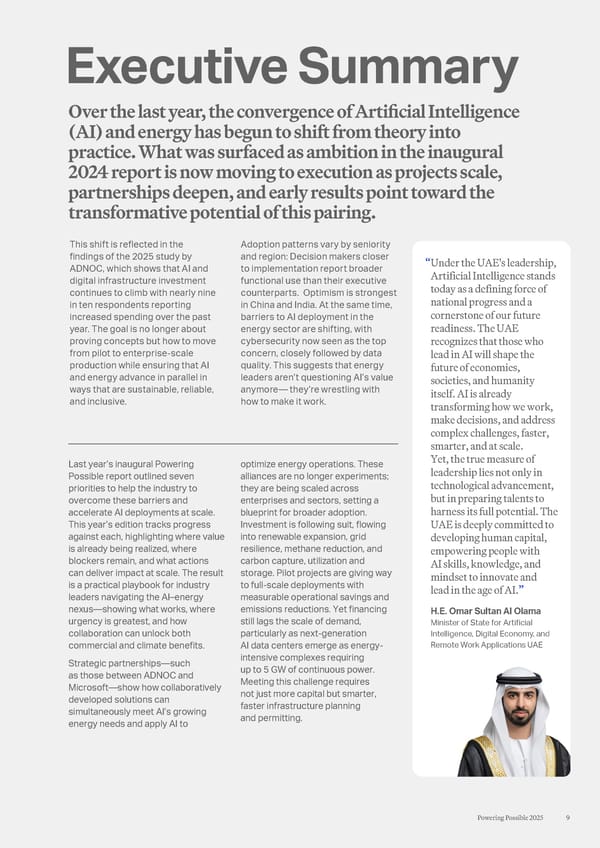This shift is reflected in the findings of the 2025 study by ADNOC, which shows that AI and digital infrastructure investment continues to climb with nearly nine in ten respondents reporting increased spending over the past year. The goal is no longer about proving concepts but how to move from pilot to enterprise-scale production while ensuring that AI and energy advance in parallel in ways that are sustainable, reliable, and inclusive. Executive Summary Over the last year, the convergence of Artificial Intelligence (AI) and energy has begun to shift from theory into practice. What was surfaced as ambition in the inaugural 2024 report is now moving to execution as projects scale, partnerships deepen, and early results point toward the transformative potential of this pairing. Adoption patterns vary by seniority and region: Decision makers closer to implementation report broader functional use than their executive counterparts. Optimism is strongest in China and India. At the same time, barriers to AI deployment in the energy sector are shifting, with cybersecurity now seen as the top concern, closely followed by data quality. This suggests that energy leaders arent questioning AIs value anymore theyre wrestling with how to make it work. Last years inaugural Powering Possible report outlined seven priorities to help the industry to overcome these barriers and accelerate AI deployments at scale. This years edition tracks progress against each, highlighting where value is already being realized, where blockers remain, and what actions can deliver impact at scale. The result is a practical playbook for industry leaders navigating the AIenergy nexusshowing what works, where urgency is greatest, and how collaboration can unlock both commercial and climate benefits. Strategic partnershipssuch as those between ADNOC and Microsoftshow how collaboratively developed solutions can simultaneously meet AIs growing energy needs and apply AI to optimize energy operations. These alliances are no longer experiments; they are being scaled across enterprises and sectors, setting a blueprint for broader adoption. Investment is following suit, flowing into renewable expansion, grid resilience, methane reduction, and carbon capture, utilization and storage. Pilot projects are giving way to full-scale deployments with measurable operational savings and emissions reductions. Yet financing still lags the scale of demand, particularly as next-generation AI data centers emerge as energy- intensive complexes requiring up to 5 GW of continuous power. Meeting this challenge requires not just more capital but smarter, faster infrastructure planning and permitting. Under the UAE's leadership, Artificial Intelligence stands today as a defining force of national progress and a cornerstone of our future readiness. The UAE recognizes that those who lead in AI will shape the future of economies, societies, and humanity itself. AI is already transforming how we work, make decisions, and address complex challenges, faster, smarter, and at scale. Yet, the true measure of leadership lies not only in technological advancement, but in preparing talents to harness its full potential. The UAE is deeply committed to developing human capital, empowering people with AI skills, knowledge, and mindset to innovate and lead in the age of AI. H.E. Omar Sultan Al Olama Minister of State for Artificial Intelligence, Digital Economy, and Remote Work Applications UAE 7 Powering Possible 2025
 Powering Possible 2025: Unleashing AI for Energy and Energy for AI Page 6 Page 8
Powering Possible 2025: Unleashing AI for Energy and Energy for AI Page 6 Page 8